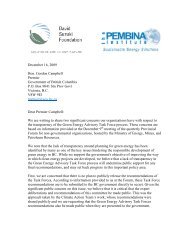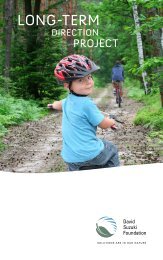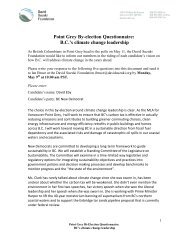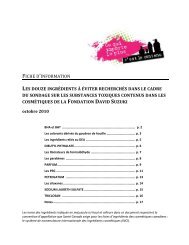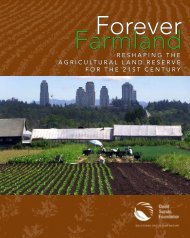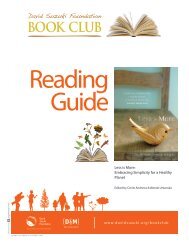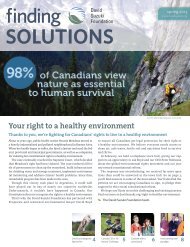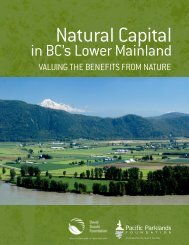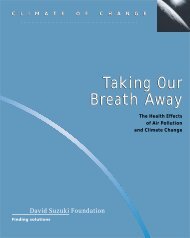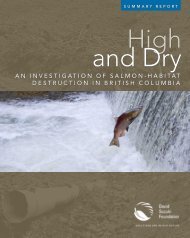Toward an Ecosystem Approach to Bottom Trawling in Canada
Toward an Ecosystem Approach to Bottom Trawling in Canada
Toward an Ecosystem Approach to Bottom Trawling in Canada
- No tags were found...
You also want an ePaper? Increase the reach of your titles
YUMPU automatically turns print PDFs into web optimized ePapers that Google loves.
Dragg<strong>in</strong>g Our Assets:<strong>Toward</strong> <strong>an</strong> <strong>Ecosystem</strong> <strong>Approach</strong> <strong>to</strong> Bot<strong>to</strong>m <strong>Trawl<strong>in</strong>g</strong> <strong>in</strong> C<strong>an</strong>ada© 2007 David Suzuki FoundationISBN 1-897375-10-7C<strong>an</strong>adi<strong>an</strong> Catalogu<strong>in</strong>g <strong>in</strong> Publication Data for this book is available throughthe National Library of C<strong>an</strong>adawritten by: Scott Wallace, PhDDavid Suzuki Foundation susta<strong>in</strong>able fisheries <strong>an</strong>alyst Scott Wallace has a PhD <strong>in</strong> ResourceM<strong>an</strong>agement from the University of British Columbia. His research <strong>in</strong>terests <strong>in</strong>clude fisheriesimpacts on mar<strong>in</strong>e ecosystems, the use of mar<strong>in</strong>e protected areas as a <strong>to</strong>ol for fisheriesm<strong>an</strong>agement, ecosystem-based fisheries m<strong>an</strong>agement, <strong>an</strong>d the conservation of mar<strong>in</strong>e speciesat risk.AcknowledgementsThe David Suzuki Foundation would like <strong>to</strong> th<strong>an</strong>k Sus<strong>an</strong>na Fuller at the Ecology Action Centre<strong>in</strong> Halifax, Nova Scotia for her contributions <strong>to</strong> the Atl<strong>an</strong>tic sections of this report.Special th<strong>an</strong>ks <strong>to</strong> Jason Curr<strong>an</strong>, I<strong>an</strong> H<strong>an</strong><strong>in</strong>g<strong>to</strong>n, Jay Ritchl<strong>in</strong>, Jodi Stark <strong>an</strong>d Bill Warehamfor contributions <strong>in</strong> edit<strong>in</strong>g of this report.This report was made possible by the generous support of the R. Howard Webster Foundation.David Suzuki Foundation2211 West 4th Avenue, Suite 219V<strong>an</strong>couver, B.C., C<strong>an</strong>ada V6K 4S2www.davidsuzuki.orgTel 604.732.4228Fax 604.732.0752design <strong>an</strong>d production: Alaris Designpho<strong>to</strong>graphs: Diagram of trawl<strong>in</strong>g (page 3): Joe Shoulak (www.joeshoulak.com); Figure 1 (page 5):Department of Fisheries <strong>an</strong>d Oce<strong>an</strong>s; Figure 7 (page 14): Dr. M<strong>an</strong>fred Krautter, Universitaet H<strong>an</strong>nover,Germ<strong>an</strong>y; Thornyhead (page 16): Archipelago Mar<strong>in</strong>e Research Ltd.; Figure 13 (page 22): Departmen<strong>to</strong>f Fisheries <strong>an</strong>d Oce<strong>an</strong>s; Figure 18 (page 25): Department of Fisheries <strong>an</strong>d Oce<strong>an</strong>s
ContentsA. INTRODUCTION | 1B. ECOLOGICAL IMPACTS FROM BOTTOM TRAWLING | 4Direct Effects | 4Habitat loss | 5Ch<strong>an</strong>ge <strong>in</strong> species composition | 5Reduction <strong>in</strong> overall productivity | 5Natural Disturb<strong>an</strong>ce | 6Indirect Effects | 6Sediment processes | 6Food web <strong>an</strong>d community structure impacts | 6Unknown Effects | 7C. OVERVIEW OF BOTTOM TRAWLING | 8Scale of the problem: spatial footpr<strong>in</strong>t | 8The import<strong>an</strong>ce of habitat type | 8Pacific Coast | 9Trend <strong>in</strong> area trawled | 11Types of habitat trawled | 13Special concerns | 13Frontier areas | 14Summary of bot<strong>to</strong>m trawl<strong>in</strong>g <strong>in</strong> Pacific Waters | 16Atl<strong>an</strong>tic C<strong>an</strong>ada | 17Trend <strong>in</strong> area trawled | 19Habitat impacts | 22Frontier areas | 23Impacts on habitat | 24Summary of bot<strong>to</strong>m trawl<strong>in</strong>g <strong>in</strong> Atl<strong>an</strong>tic Waters | 27D. CANADA’S “SUSTAINABLE USE” APPROACH | 28E. EXPERIENCE FROM OTHER JURISDICTIONS | 29United States | 30Australia | 31New Zeal<strong>an</strong>d | 32Europe<strong>an</strong> Union | 33Lessons for C<strong>an</strong>ada | 33F. RECENT INITIATIVES TO REGULATEBOTTOM TRAWLING ON THE HIGH SEAS | 34United Nations General Assembly Resolution | 34South Pacific Regional Fisheries M<strong>an</strong>agement Org<strong>an</strong>ization | 34Lessons for C<strong>an</strong>ada from the high seas | 35
DRAGGING OUR ASSETS9Seventy-five per cent of C<strong>an</strong>ada’s Pacific Exclusive Economic Zone is considered as abyssalwaters greater th<strong>an</strong> 1,000 metres, which is mostly beyond the current maximum trawl<strong>in</strong>gdepth <strong>in</strong> B.C. of 1,200 metres. The actual area trawled <strong>in</strong> non-abyssal waters is about 36per cent, or six times greater th<strong>an</strong> the area claimed by <strong>in</strong>dustry. <strong>Ecosystem</strong>-based policy<strong>an</strong>d regulation require a better underst<strong>an</strong>d<strong>in</strong>g of trawl distribution <strong>in</strong> relation <strong>to</strong> habitattype on both the Atl<strong>an</strong>tic <strong>an</strong>d the Pacific coasts as a necessary first step.Pacific CoastIn November 2006, DFO produced a paper exam<strong>in</strong><strong>in</strong>g the spatial extent of bot<strong>to</strong>m trawl<strong>in</strong>gby commercial groundfish fisheries <strong>in</strong> C<strong>an</strong>ada’s Pacific waters. 23 This <strong>an</strong>alysis concludedthat between 1996 <strong>an</strong>d 2005, a cumulative <strong>to</strong>tal of 38,320 square kilometres of the oce<strong>an</strong>floor had been contacted by bot<strong>to</strong>m trawl<strong>in</strong>g based on one-by-one kilometre grid squares. 24Further <strong>an</strong>alysis by the David Suzuki Foundation found that the spatial extent of bot<strong>to</strong>mtrawl<strong>in</strong>g was very <strong>in</strong>tensive <strong>in</strong> some depths <strong>an</strong>d some areas. For example, along the west coas<strong>to</strong>f V<strong>an</strong>couver Isl<strong>an</strong>d <strong>in</strong> the depth r<strong>an</strong>ge of 150 <strong>to</strong> 1,200 metres, 97 per cent of the area hadbeen contacted by bot<strong>to</strong>m trawl gear over the last decade based on presence <strong>an</strong>d absence oftrawl<strong>in</strong>g <strong>in</strong> one-square-kilometre grid cells (Table 1, Figure 3). In the depth r<strong>an</strong>ge of 150 <strong>to</strong>500 metres, 100 per cent of the area had been contacted by trawl gear over this same timeperiod. Bot<strong>to</strong>m trawl<strong>in</strong>g has been conducted for approximately 60 years throughout muchP a c i f i c C o a s t B o t t o m T r a w l P r o f i l eFisheries us<strong>in</strong>g bot<strong>to</strong>m trawl<strong>in</strong>g <strong>in</strong> Pacific C<strong>an</strong>ada: groundfish <strong>an</strong>d shrimp.Percent of <strong>to</strong>tal seafood l<strong>an</strong>d<strong>in</strong>gs by bot<strong>to</strong>m trawl:20 ~17 per centGroundfishNumber of groundfish bot<strong>to</strong>m-trawl licences: 142Number of active groundfish bot<strong>to</strong>m-trawl licences: ~74Primary species caught (descend<strong>in</strong>g order): Arrow<strong>to</strong>oth flounder, Pacific oce<strong>an</strong>perch, Dover sole, yellowtail rockfish, yellowmouth rockfish, l<strong>in</strong>gcod, rock sole, sp<strong>in</strong>ydogfish, silvergray rockfish, big skate, Pacific cod <strong>an</strong>d English sole.Total footpr<strong>in</strong>t (see description <strong>in</strong> text): ~38,000 km 2Hours of bot<strong>to</strong>m trawl<strong>in</strong>g per year: 30,000 - 40,000Habitat type trawled21: S<strong>an</strong>d <strong>an</strong>d gravels (~40 per cent of trawled area), mud (30 percent), bedrock (~25 per cent), other (~five per cent).Average catch: 38,500 <strong>to</strong>nnes (~23 per cent of catch is discarded).Shrimp TrawlNumber of shrimp trawl licences: 248 eligible licensesNumber of active shrimp trawl licences 22 : ~80Primary species caught (descend<strong>in</strong>g order): smooth p<strong>in</strong>k, northern p<strong>in</strong>k, <strong>an</strong>dsidestripe shrimpTotal footpr<strong>in</strong>t: UnknownShrimp trawl<strong>in</strong>g grounds available: ~11400 km 2Hours of trawl<strong>in</strong>g per year: Decl<strong>in</strong>e from ~84,000 hrs/yr <strong>to</strong> ~23,000 hrs/yr (2005)Habitat type: soft bot<strong>to</strong>ms, mud <strong>an</strong>d s<strong>an</strong>d
10 overview of bot<strong>to</strong>m trawl<strong>in</strong>gof B.C.’s cont<strong>in</strong>ental shelf; however, precise geo-referenced data (i.e., GPS coord<strong>in</strong>ates oftrawl <strong>to</strong>ws) has only been systematically collected for a decade. <strong>Trawl<strong>in</strong>g</strong> effort (i.e., numberof hours of trawl<strong>in</strong>g) was his<strong>to</strong>rically much higher th<strong>an</strong> it is <strong>to</strong>day <strong>an</strong>d therefore it is fair<strong>to</strong> assume that these areas have been trawled several times dur<strong>in</strong>g the past 60 years. Giventhat the most sensitive habitats are destroyed from the first few fish<strong>in</strong>g events, it is unlikelythat <strong>an</strong>y large tracts of sensitive habitat still exist along the west coast of V<strong>an</strong>couver Isl<strong>an</strong>d<strong>in</strong> the depth r<strong>an</strong>ge of 150 <strong>to</strong> 1,200 metres.TABLE 1Table show<strong>in</strong>g the area bot<strong>to</strong>m trawled <strong>in</strong> British Columbia by depth strata<strong>an</strong>d Pacific Fisheries M<strong>an</strong>agement Areas from 1996 <strong>to</strong> 2005. Trawled areabased on trawl <strong>to</strong>ws tr<strong>an</strong>sect<strong>in</strong>g one-square-kilometre grid squares. 25 Thedata <strong>in</strong> these tables were derived from <strong>an</strong> overlay of a GIS shapefile ofm<strong>an</strong>agement areas (provided by DFO) <strong>an</strong>d a bathymetry comb<strong>in</strong>ed withpublished outputs of cumulative trawled area by m<strong>an</strong>agement area. 26TOTAL AREA (KM2) IN DEPTH STRATA AND PFMADepth 3CD 5AB 5CD 5E All areas0-150 13283 14771 27833 2523 58411150-500 3746 14574 14434 3817 36570500-1200 4996 2539 40 3583 11158All Depths 22025 31884 42307 9924 106140cumulative new area (KM2) trawled (1996-2005) by Depth strata <strong>an</strong>d pfmaDepth 3CD 5AB 5CD 5E All areas0-150 4305 3918 5550 10 13783150-500 3762 7408 4249 1869 17288500-1200 4677 871 1704 7249All Depths 12744 12194 9799 3583 38320percentage of area trawled by depth strata <strong>an</strong>d PFMA (1996-2005)Depth 3CD 5AB 5CD 5E All areas0-150 32 27 20 0 24150-500 100 51 29 49 47500-1200 34 0 65All Depths 58 38 23 36 36
DRAGGING OUR ASSETS15C<strong>an</strong>ada’s deep-sea (>500 metres) trawl fishery is poorly unders<strong>to</strong>od; however, based onexperience elsewhere the habitat <strong>an</strong>d water quality impacts are likely signific<strong>an</strong>t due <strong>to</strong> thelow natural disturb<strong>an</strong>ce of deep-sea habitats. 33Annually, there are still <strong>in</strong>cremental <strong>in</strong>cursions <strong>in</strong><strong>to</strong> new areas by the groundfish trawlfishery. S<strong>in</strong>ce 2003, <strong>an</strong> additional 703 square kilometres (0.5 per cent of <strong>to</strong>tal area trawled)of seafloor area has been trawled that had not been accessed from 1996 <strong>to</strong> 2002 (Figure 8).34It is unknown whether these “new” areas had been accessed <strong>in</strong> the 50 years of trawl<strong>in</strong>g onthe Pacific Coast prior <strong>to</strong> 1996. In the short term, improved technologies allow<strong>in</strong>g <strong>in</strong>cursionsaround the edges of previously untrawlable areas may lead <strong>to</strong> additional exp<strong>an</strong>sion.Under present m<strong>an</strong>agement <strong>an</strong>d market conditions there is little <strong>in</strong>centive for exp<strong>an</strong>d<strong>in</strong>g<strong>in</strong><strong>to</strong> large unexplored areas; however, these conditions c<strong>an</strong> ch<strong>an</strong>ge over relatively shortperiods. Similarly, the shrimp-trawl fishery is largely conf<strong>in</strong>ed <strong>to</strong> traditional areas with noimmediate <strong>in</strong>centive for further exp<strong>an</strong>sion.2500020000>500 mArea trawled (km2)1500010000150-500 m0-150 m5000315 km 2201 km 2187 km 201996 1997 1998 1999 2000 2001 2002 2003 2004 2005Figure 8. Annual <strong>in</strong>cremental new area trawled (km 2 ) by groundfish trawlers on C<strong>an</strong>ada’s Pacific Coast beg<strong>in</strong>n<strong>in</strong>g<strong>in</strong> 1996 based on presence/absence of trawl <strong>to</strong>ws through one-km 2 grid cells. Data source: S<strong>in</strong>clair (2007).Year
16 overview of bot<strong>to</strong>m trawl<strong>in</strong>gDeep Sea Longsp<strong>in</strong>eThornyhead FisheryBEGINNING IN 1996, British Columbia’sgroundfish bot<strong>to</strong>m-trawl fishery startedmak<strong>in</strong>g regular trips <strong>in</strong><strong>to</strong> waters deeperth<strong>an</strong> 500 metres <strong>to</strong> pursue a little-knownfish species called the longsp<strong>in</strong>e thornyhead.Commercial catches peaked onlythree years later <strong>in</strong> 1999, <strong>an</strong>d s<strong>in</strong>ce thattime catch rates have decl<strong>in</strong>ed dramaticallycoast-wide suggest<strong>in</strong>g a rapid reduction<strong>in</strong> the abund<strong>an</strong>ce of this species.The reduction has been so severe that theCommittee on the Status of End<strong>an</strong>geredWildlife <strong>in</strong> C<strong>an</strong>ada (COSEWIC) recentlylisted this species as Special Concern. 35The preferred depth of the longsp<strong>in</strong>ethornyhead is between 600 <strong>an</strong>d 1,200metres, with the highest commercial catchrates <strong>in</strong> British Columbia occurr<strong>in</strong>g at about855 metres depth. 36 Off the West Coast ofC<strong>an</strong>ada, oxygen saturation <strong>in</strong> the watersbetween 600 <strong>an</strong>d 1,000 metres is extremelylow <strong>an</strong>d is technically classified as the oxygenm<strong>in</strong>imum zone. 37 While the depletionof the longsp<strong>in</strong>e thornyhead has beendocumented, the ecosystem consequencesof both habitat damage <strong>an</strong>d releas<strong>in</strong>gsediment compris<strong>in</strong>g org<strong>an</strong>ic matter <strong>in</strong><strong>to</strong><strong>an</strong> already oxygen-poor environmentare unknown. Empirical evidence fromelsewhere shows that oxygen levels <strong>in</strong> thewater column c<strong>an</strong> be reduced after bot<strong>to</strong>mtrawl<strong>in</strong>g. 38 The depletion of oxygen maybe caused by <strong>an</strong> <strong>in</strong>creased rate of bacterialrespiration or alternatively through chemicalconsumption through reactions withhydrogen sulfide <strong>an</strong>d meth<strong>an</strong>e. Researchexam<strong>in</strong><strong>in</strong>g the impact of bot<strong>to</strong>m trawl<strong>in</strong>gon oxygen levels <strong>in</strong> the oxygen m<strong>in</strong>imumzone has not been undertaken.The geographical scale of this fisheryrelative <strong>to</strong> the available habitat area <strong>in</strong> thedepth zone is signific<strong>an</strong>t. The longsp<strong>in</strong>ethornyhead is sparsely distributed overs<strong>an</strong>dy bot<strong>to</strong>ms. To make the trawl <strong>to</strong>wscost-effective at this low density, the <strong>to</strong>wsare on average seven hours long <strong>an</strong>d coverover 30 kilometres. 39 As of May 2007, moreth<strong>an</strong> 15,000 trawl <strong>to</strong>ws have been directedat the longsp<strong>in</strong>e thornyhead over 10 years,cover<strong>in</strong>g a dist<strong>an</strong>ce of nearly 500,000kilometres. Between 1996 <strong>an</strong>d 2005, 86per cent of the catch was taken from thecont<strong>in</strong>ental slope off the west coast ofV<strong>an</strong>couver Isl<strong>an</strong>d. In the process 94 percent of the seafloor <strong>in</strong> the depth r<strong>an</strong>ge of500 <strong>to</strong> 1,200 metres has been trawled <strong>in</strong>this area. 40Clearly, this fishery is not m<strong>an</strong>agedwith broader ecosystem consequences <strong>in</strong>m<strong>in</strong>d.Summary of bot<strong>to</strong>m trawl<strong>in</strong>g <strong>in</strong> Pacific watersGenerally, the <strong>in</strong>tensity (effort) <strong>an</strong>d <strong>an</strong>nual area trawled by British Columbia’s bot<strong>to</strong>m-trawlfisheries (groundfish <strong>an</strong>d shrimp) have been reduced over the past few years. The <strong>to</strong>tal volumeof fish caught by groundfish bot<strong>to</strong>m-trawl fishery has rema<strong>in</strong>ed stable at about 39,000<strong>to</strong>nnes for the past 10 years. Approximately 23 per cent of the catch is discarded. Underpresent m<strong>an</strong>agement <strong>an</strong>d market conditions there does not appear <strong>to</strong> be <strong>an</strong>y immediateconcern regard<strong>in</strong>g the exp<strong>an</strong>sion of the area trawled; however, these conditions c<strong>an</strong> ch<strong>an</strong>gequickly <strong>an</strong>d therefore immediate safeguards must be put <strong>in</strong> place. The exp<strong>an</strong>sion of the deep-
DRAGGING OUR ASSETS17water bot<strong>to</strong>m-trawl fishery (> 500 metres) for longsp<strong>in</strong>e thornyhead dur<strong>in</strong>g the late 1990s<strong>an</strong>d early part of this decade is a clear example of how quickly a fishery c<strong>an</strong> exp<strong>an</strong>d. Overthe course of 10 years, this fishery impacted huge tracts of previously untrawled grounds(about 7,000 square kilometres) <strong>an</strong>d depleted the abund<strong>an</strong>ce of the target species <strong>to</strong> thepo<strong>in</strong>t of be<strong>in</strong>g listed as a Species at Risk. The ongo<strong>in</strong>g ecological impacts with this fisheryon the deep-sea cont<strong>in</strong>ental slope ecosystem cont<strong>in</strong>ue <strong>to</strong> be a concern, especially given thelow natural disturb<strong>an</strong>ce regime (it is <strong>an</strong> area not adapted <strong>to</strong> large, frequent disturb<strong>an</strong>ces),extremely low oxygen concentrations, <strong>an</strong>d massive ch<strong>an</strong>ge <strong>in</strong> community structure due thedepletion of the predom<strong>in</strong><strong>an</strong>t fish species.Atl<strong>an</strong>tic C<strong>an</strong>adaThe Atl<strong>an</strong>tic cont<strong>in</strong>ental shelf (zero <strong>to</strong> 2,000 metres) is much larger th<strong>an</strong> the Pacific shelf<strong>an</strong>d covers about 1.3 million square kilometres. The width of the shelf extends a m<strong>in</strong>imumof 175 kilometres from nearest l<strong>an</strong>d (off Labrador) <strong>to</strong> a maximum of 650 kilometres <strong>to</strong>the outer Flemish Cap (see figure 11). This shelf provides a very large <strong>an</strong>d diverse fish<strong>in</strong>gground, <strong>in</strong>clud<strong>in</strong>g subst<strong>an</strong>tial area accessed by bot<strong>to</strong>m trawl<strong>in</strong>g. Bot<strong>to</strong>m trawl<strong>in</strong>g on theshelf is primarily for groundfish <strong>an</strong>d shrimp.Patterns of bot<strong>to</strong>m trawl<strong>in</strong>g have ch<strong>an</strong>ged over time as the fishery tr<strong>an</strong>sitioned from oneprimarily fish<strong>in</strong>g for Atl<strong>an</strong>tic cod <strong>an</strong>d other groundfish <strong>to</strong> one target<strong>in</strong>g shrimp <strong>an</strong>d lesseramounts of groundfish, particularly <strong>in</strong> the years follow<strong>in</strong>g the groundfish collapse (post-1992) (Figure 9). <strong>Trawl<strong>in</strong>g</strong> effort has decreased on the cod b<strong>an</strong>ks <strong>in</strong> those years; however,effort has also exp<strong>an</strong>ded <strong>to</strong> frontier areas as shrimp populations are sought.A t l a n t i c C o a s t B o t t o m T r a w l P r o f i l eTypes of bot<strong>to</strong>m trawl<strong>in</strong>g <strong>in</strong> Atl<strong>an</strong>tic C<strong>an</strong>ada: groundfish <strong>an</strong>d shrimpPERCent of <strong>to</strong>tal seafood l<strong>an</strong>d<strong>in</strong>gs by bot<strong>to</strong>m trawl: 41 about 23 per centGroundfishNumber of groundfish bot<strong>to</strong>m-trawl licences: Maritimes Region, about 467 42Number of active groundfish bot<strong>to</strong>m-trawl licences: Maritimes region, 166Primary species caught: Atl<strong>an</strong>tic cod, redfish, witch flounder, Americ<strong>an</strong> plaice, skate.Total footpr<strong>in</strong>t (see description below): 1980s, about 390,000 square kilometers;present day, about 200,000 square kilometers. 43Habitat type trawled: Not availableShrimp TrawlNumber of shrimp-trawl licences: Scotia Fundy, 23; Gulf, 29; Newfoundl<strong>an</strong>d <strong>an</strong>dLabrador, 17Number of active shrimp-trawl licences: Not availablePrimary species caught: northern shrimpTotal footpr<strong>in</strong>t: UnknownHabitat type: soft bot<strong>to</strong>ms, mud <strong>an</strong>d s<strong>an</strong>d
18 overview of bot<strong>to</strong>m trawl<strong>in</strong>g1,400,0001,200,0001,000,000Northern shrimpAtl<strong>an</strong>tic codL<strong>an</strong>d<strong>in</strong>gs (t)800,000600,000400,000200,000019501955196019651970197519801985199019952000YearFigure 9. L<strong>an</strong>d<strong>in</strong>gs (<strong>to</strong>nnes) of Atl<strong>an</strong>tic cod <strong>an</strong>d northern shrimp <strong>in</strong> C<strong>an</strong>ada’s Atl<strong>an</strong>tic waters.The Atl<strong>an</strong>tic Region has four Fisheries <strong>an</strong>d Oce<strong>an</strong>s C<strong>an</strong>ada science <strong>an</strong>d m<strong>an</strong>agementregions, <strong>an</strong>d each region compiles <strong>an</strong>d <strong>an</strong>alyzes data separately. Recent <strong>an</strong>alyses similar <strong>to</strong>the Pacific Coast, where area trawled <strong>in</strong>formation is available, is not currently availablefor the entire Atl<strong>an</strong>tic Coast. The Scotia Fundy Region has assembled figures of l<strong>an</strong>d<strong>in</strong>gsbroken down accord<strong>in</strong>g <strong>to</strong> gear type 44 (Figure 10). Fisheries <strong>an</strong>d Oce<strong>an</strong>s C<strong>an</strong>ada is currentlyundertak<strong>in</strong>g a comprehensive assessment of the spatial distribution <strong>an</strong>d impact ofall bot<strong>to</strong>m-contact fish<strong>in</strong>g gears <strong>in</strong> Atl<strong>an</strong>tic C<strong>an</strong>ada. The results of this assessment shouldbe available <strong>in</strong> late 2007. 45
Dragg<strong>in</strong>g our assets19Figure 10. L<strong>an</strong>d<strong>in</strong>gs of groundfish between 1999 <strong>an</strong>d 2003 <strong>in</strong> the Scotia Fundy Region by gear type.Note: mobile gear is bot<strong>to</strong>m trawl<strong>in</strong>g.Trend <strong>in</strong> area trawledOnly one study has been previously published on the distribution of all trawl<strong>in</strong>g effort <strong>in</strong>Atl<strong>an</strong>tic C<strong>an</strong>ada (Figure 11). The spatial extent of the trawl fleet is not well known prior<strong>to</strong> 1980. Throughout the early <strong>to</strong> mid-1980s, trawl <strong>in</strong>tensity on the shelf was at its greatest<strong>in</strong> the recorded period (1980 <strong>to</strong> 2000). From 1980 <strong>to</strong> 1986, the area trawled decreasedfrom about 390,000 square kilometres (38 per cent of <strong>to</strong>tal shelf area) <strong>to</strong> 290,000 squarekilometers, or 27 per cent of <strong>to</strong>tal area. The area trawled decreased <strong>to</strong> a recorded low of90,000 square kilometres (eight per cent of <strong>to</strong>tal area) <strong>in</strong> 1997 before <strong>in</strong>creas<strong>in</strong>g <strong>to</strong> 205,000square kilometres (20 per cent) <strong>in</strong> 1999/2000 due <strong>to</strong> <strong>an</strong> exp<strong>an</strong>d<strong>in</strong>g shrimp fishery. 46
20 overview of bot<strong>to</strong>m trawl<strong>in</strong>gMap Source: Kulka <strong>an</strong>d Pitcher 2001,ICES CM 2001/R:02.Laurenti<strong>an</strong>Ch<strong>an</strong>nelGr<strong>an</strong>dB<strong>an</strong>kFlemishCapScoti<strong>an</strong>ShelfGeorgesB<strong>an</strong>kTail of theB<strong>an</strong>kFigure 11. Map depict<strong>in</strong>g persistent areas of high-<strong>in</strong>tensity bot<strong>to</strong>m trawl<strong>in</strong>g <strong>in</strong> the Atl<strong>an</strong>tic over the timeperiod 1990 <strong>to</strong> 2000. Legend: Dur<strong>in</strong>g time period, light blue-untrawled; dark blue-trawled once; green/yellow-trawled three <strong>to</strong> n<strong>in</strong>e times; or<strong>an</strong>ge/red-area trawled 10 <strong>to</strong> 11 times.In all 21 years of available data, the most used trawl<strong>in</strong>g grounds were centred on GeorgesB<strong>an</strong>k <strong>an</strong>d the Scoti<strong>an</strong> Shelf, extend<strong>in</strong>g <strong>in</strong> a cont<strong>in</strong>uous b<strong>an</strong>d along the outer Scoti<strong>an</strong> Shelf<strong>to</strong> the southwest slope of the Gr<strong>an</strong>d B<strong>an</strong>k <strong>an</strong>d extend<strong>in</strong>g <strong>to</strong> <strong>in</strong>clude the western slope ofthe Laurenti<strong>an</strong> Ch<strong>an</strong>nel (Figure 11). On the Flemish Cap, a shrimp fishery commenced <strong>in</strong>1994 that greatly <strong>in</strong>creased the extent of effort on the northern part of the Cap start<strong>in</strong>g <strong>in</strong>1994 <strong>an</strong>d persist<strong>in</strong>g through 2000.Across all years (1980 <strong>to</strong> 2000), most trawl effort <strong>in</strong> Atl<strong>an</strong>tic C<strong>an</strong>ada occurred at depthsless th<strong>an</strong> 350 metres. However, the proportion of trawl<strong>in</strong>g at greater depths, exceed<strong>in</strong>g 600metres, shifted dramatically between 1992 <strong>an</strong>d 1994 correspond<strong>in</strong>g <strong>to</strong> the collapse of <strong>an</strong>umber of s<strong>to</strong>cks, ultimately result<strong>in</strong>g <strong>in</strong> a closure of the fishery. Recent trawl<strong>in</strong>g effort isoffshore with effort <strong>in</strong>creas<strong>in</strong>g <strong>in</strong> northern areas (Figure 12).
dragg<strong>in</strong>g our assets21Figure 12. Trawl fish<strong>in</strong>g effort for both groundfish <strong>an</strong>d shrimp fisheries for vessels >65 feet <strong>in</strong> Newfoundl<strong>an</strong>d<strong>an</strong>d Labrador <strong>in</strong> 2004 <strong>an</strong>d 2005. 47
22 overview of bot<strong>to</strong>m trawl<strong>in</strong>gH a b i t a t i m p a c t sFishermen have raised commercial fish-habitat concerns <strong>in</strong> Atl<strong>an</strong>tic C<strong>an</strong>ada, specificallyrelated <strong>to</strong> the impacts of trawl<strong>in</strong>g, s<strong>in</strong>ce the beg<strong>in</strong>n<strong>in</strong>g of the large-scale trawler fisheryfollow<strong>in</strong>g the First World War. 48 Specifically, <strong>an</strong>ecdotal reports of the impacts of trawl<strong>in</strong>gon cold-water corals on the Scoti<strong>an</strong> Shelf collected <strong>in</strong> the late 1990s were among the firstdocumentation of reported coral locations <strong>an</strong>d fishery-related destruction <strong>in</strong> the NorthwestAtl<strong>an</strong>tic 49 . In situ data of corals <strong>in</strong> the Northeast Ch<strong>an</strong>nel, between Georges <strong>an</strong>d BrownsB<strong>an</strong>k, found evidence of damage from fish<strong>in</strong>g gear. 50 A closed area of 424 square kilometreswas established <strong>in</strong> 2002 <strong>to</strong> protect corals rema<strong>in</strong><strong>in</strong>g <strong>in</strong> the area. Additional pho<strong>to</strong>graphicdata from coral beds <strong>in</strong> the S<strong>to</strong>ne Fence area, at the entr<strong>an</strong>ce <strong>to</strong> the Laurenti<strong>an</strong> Ch<strong>an</strong>nel,showed 95 per cent of Lophelia pertusa reefs destroyed (Figure 13).Figure 13. Lophelia pertusa reefs on the S<strong>to</strong>ne Fence, Scoti<strong>an</strong> Shelf.A (left) Intact Lophelia with Sebastes sp. B (right) Lophelia rubble, as a result of trawl damage.More recent documentation of corals off Newfoundl<strong>an</strong>d <strong>an</strong>d Labrador illustrates theimpact of trawl<strong>in</strong>g <strong>an</strong>d other fish<strong>in</strong>g methods on these structural species, <strong>an</strong>d shows thelocations of coral hot spots. All coral data for the Newfoundl<strong>an</strong>d work has been collectedthrough observer programs on commercial trawl vessels <strong>an</strong>d DFO trawl surveys, <strong>an</strong>dtherefore the full extent of coral distribution is unknown. 51DFO has undertaken research on the impacts of bot<strong>to</strong>m trawl<strong>in</strong>g through a series ofexperimental trawls on the Gr<strong>an</strong>d B<strong>an</strong>ks <strong>an</strong>d on the Western B<strong>an</strong>k of the Scoti<strong>an</strong> Shelf.Experiments conducted on s<strong>an</strong>dy bot<strong>to</strong>ms on the Gr<strong>an</strong>d B<strong>an</strong>ks showed recovery follow<strong>in</strong>gtrawl<strong>in</strong>g after one year. 52 Analysis of benthic samples taken follow<strong>in</strong>g experimental trawl<strong>in</strong>gon gravel habitat on the Scoti<strong>an</strong> Shelf found that <strong>in</strong>ter-<strong>an</strong>nual differences <strong>in</strong> <strong>in</strong>vertebratepopulations were greater th<strong>an</strong> that attributed <strong>to</strong> trawl impacts, as compared <strong>to</strong> control sites.The experimental site has been his<strong>to</strong>rically trawled, but had been closed for a decade at the
dragg<strong>in</strong>g our assets23time of the study. 53 Research has also been conducted on the Georges B<strong>an</strong>k, with samplesites of heavy <strong>an</strong>d light trawl effort on both the C<strong>an</strong>adi<strong>an</strong> <strong>an</strong>d U.S. sides. Results <strong>in</strong>dicatedthat areas with light trawl effort had a higher abund<strong>an</strong>ce of benthic org<strong>an</strong>isms with a communitystructured by fragile species not present on the heavily fished site. 54 Overall, muchof the experimental work done with<strong>in</strong> C<strong>an</strong>ada’s Atl<strong>an</strong>tic EEZ has yielded either <strong>in</strong>conclusiveresults or shown little effect of the experimental trawl impact, partially due <strong>to</strong> the lack ofadequate control sites (areas that have never been trawled) as well as experimental designthat has been constra<strong>in</strong>ed by sampl<strong>in</strong>g opportunities.Frontier areasFigure 14. Observer data for the ScotiaFundy region otter-trawl fleet (10 <strong>to</strong> 50per cent coverage depend<strong>in</strong>g on targetspecies <strong>an</strong>d area fished) shows the shiftfrom b<strong>an</strong>k fisheries <strong>to</strong> slope fisheries<strong>in</strong> Atl<strong>an</strong>tic C<strong>an</strong>ada, follow<strong>in</strong>g the codcollapse.Follow<strong>in</strong>g the cod collapse <strong>an</strong>d subsequentmora<strong>to</strong>ria, which beg<strong>an</strong> <strong>in</strong> 1992, fish<strong>in</strong>g onC<strong>an</strong>ada’s Atl<strong>an</strong>tic Coast exp<strong>an</strong>ded <strong>to</strong> new areas<strong>an</strong>d new depths. Observer data shows thattrawl<strong>in</strong>g rarely occurred below 600 metres untilthe early 1990s, when vessels beg<strong>an</strong> <strong>to</strong> fish offthe edges of the b<strong>an</strong>ks, along the cont<strong>in</strong>entalslope, <strong>in</strong> efforts <strong>to</strong> f<strong>in</strong>d new species <strong>an</strong>d <strong>to</strong>abide by the mora<strong>to</strong>rium on most groundfishspecies (Figure 14). While the area trawled wassignific<strong>an</strong>tly decreased as a result of the fisheriesclosures, the impact on deepwater species <strong>an</strong>dparticular cold-water structural species, suchas corals <strong>an</strong>d sponges, was <strong>in</strong>tensified. Themajority of the fishery exp<strong>an</strong>sion occurred <strong>in</strong>Newfoundl<strong>an</strong>d, as groundfish fisheries <strong>in</strong> thisregion were most affected <strong>an</strong>d vessels searchedfor alternatives.This exp<strong>an</strong>sion of the fishery was predom<strong>in</strong><strong>an</strong>tly<strong>an</strong> <strong>in</strong>crease <strong>in</strong> effort for new species –particularly Greenl<strong>an</strong>d halibut <strong>an</strong>d Northernshrimp <strong>in</strong> the North Atl<strong>an</strong>tic Fisheries Org<strong>an</strong>ization(NAFO) Areas OA <strong>an</strong>d OB, which are located <strong>in</strong> the Davis Strait, between Labrador<strong>an</strong>d Baff<strong>in</strong> Isl<strong>an</strong>d (Figures 15 & 16).
24 overview of bot<strong>to</strong>m trawl<strong>in</strong>g60005000OAOB4000L<strong>an</strong>d<strong>in</strong>gs (MT)300020001000019601963196619691972197519781981YearFigure 15. C<strong>an</strong>adi<strong>an</strong> l<strong>an</strong>d<strong>in</strong>gs of Greenl<strong>an</strong>d halibut <strong>in</strong> NAFO Areas OA <strong>an</strong>d OB. (Data from NAFO Fishstat).1984198719901993199619992002700060005000OAOBL<strong>an</strong>d<strong>in</strong>gs (MT)40003000200010000196019631966196919721975197819811984198719901993199619992002Year YearFigure 16. C<strong>an</strong>adi<strong>an</strong> Northern shrimp l<strong>an</strong>d<strong>in</strong>gs <strong>in</strong> NAFO areas OA <strong>an</strong>d OB (Arctic) from 1960 <strong>to</strong> 2003.(Data: NAFO Fishstat).I m p a c t s o n h a b i t a tIncreased fish<strong>in</strong>g effort <strong>in</strong> frontier areas has resulted <strong>in</strong> <strong>in</strong>creased catches of emergent epifaunalspecies, particularly cold-water corals <strong>an</strong>d sponges (Figure 1). These species, whichlive attached <strong>to</strong> the bot<strong>to</strong>m, are <strong>an</strong> essential component of the benthic food web. Observerdata from the Scotia Fundy Region shows sponge bycatch <strong>in</strong>creas<strong>in</strong>g by two orders ofmagnitude <strong>in</strong> the period between 1997 <strong>an</strong>d 2001 as compared <strong>to</strong> that recorded <strong>in</strong> the earlyyears of the observer program <strong>an</strong>d before the cod collapse (see Figure 17).
dragg<strong>in</strong>g our assets25Sponge Presence <strong>in</strong> Kg/Set Caught <strong>in</strong> Observer Surveys 1977-1981Sponge Presence <strong>in</strong> Kg/Set Caught <strong>in</strong> Observer Surveys 1997-20017070Latitude60504076554432211Latitude60504040140036032028024020016012080401-70-60 -50 -40Longitude-70-60 -50 -40LongitudeFigure 17. 17. Observer data from data the from Scotia the Fundy Scotia Region, Fundy <strong>in</strong>dicat<strong>in</strong>g Region, trawl effort <strong>in</strong>dicat<strong>in</strong>g <strong>an</strong>d sponge trawl bycatch. effort 55<strong>an</strong>dcotia Fundy Figure sponge Region, 17. Observer bycatch. <strong>in</strong>dicat<strong>in</strong>g 55data from trawl the effort Scotia <strong>an</strong>d Fundy Region, <strong>in</strong>dicat<strong>in</strong>g trawl effort <strong>an</strong>dsponge bycatch. Bycatch of 55 cold-water coral has also been recorded, both <strong>in</strong> trawl surveys <strong>an</strong>d <strong>in</strong> the Newfoundl<strong>an</strong>dof Region cold-water Observer coral data. has Figure also been 18 shows recorded, recent both catches <strong>in</strong> trawl of Paragorgia surveys arborea <strong>an</strong>d <strong>in</strong> <strong>an</strong>d theBycatchbeen Bycatch recorded,Newfoundl<strong>an</strong>d Primnoa of both cold-water resedeaformis <strong>in</strong> trawlRegioncoral surveys <strong>in</strong> Observerhas a research <strong>an</strong>d also <strong>in</strong>data.been survey theFigurerecorded, <strong>in</strong> NAFO 18 showsboth area OB <strong>in</strong>recenttrawl us<strong>in</strong>g catchessurveys shrimp-trawl of<strong>an</strong>dParagorgia<strong>in</strong> gear. thearborea <strong>an</strong>d Primnoa resedeaformis <strong>in</strong> a research survey <strong>in</strong> NAFO area OB us<strong>in</strong>ga. Figure Newfoundl<strong>an</strong>d 18 shows recent Region catches Observer of Paragorgia data. Figure 18 shows recent catches of Paragorgiashrimp-trawl gear.<strong>in</strong> a research arborea survey <strong>an</strong>d Primnoa <strong>in</strong> NAFO resedeaformis area OB us<strong>in</strong>ga research survey <strong>in</strong> NAFO area OB us<strong>in</strong>gshrimp-trawl gear.Pho<strong>to</strong> no longer availableMarch 2008Figure 18. Cold-water coral (Paragoria arborea <strong>an</strong>d Primnoa spp) caught <strong>in</strong> shrimptrawlsurvey <strong>in</strong> September 2006 <strong>in</strong> the Davis Strait area. Pho<strong>to</strong>: DFO Newfoundl<strong>an</strong>dFigure 18. (Paragoria arborea <strong>an</strong>d Primnoa spp) caught <strong>in</strong> shrimp-trawl survey <strong>in</strong> Septemberria arborea Figure Region. <strong>an</strong>d 18. Cold-water Primnoa spp) coral caught (Paragoria <strong>in</strong> shrimpheDavis trawl Strait survey area. <strong>in</strong> Pho<strong>to</strong>: September DFO 2006 Newfoundl<strong>an</strong>d <strong>in</strong> the Davis Strait area. Pho<strong>to</strong>: DFO Newfoundl<strong>an</strong>darborea <strong>an</strong>d Primnoa spp) caught <strong>in</strong> shrimp-2006 <strong>in</strong> the Davis Strait area. Pho<strong>to</strong>: DFO Newfoundl<strong>an</strong>d Region.Region. A recent report on cold-water coral bycatch illustrates areas of high-density catches forall gear A recent types report (Figure on cold-water 19). Both coral cold-water bycatch corals illustrates <strong>an</strong>d areas sponges of high-density are sessile <strong>an</strong>d catches slowgrow<strong>in</strong>g.all gear types The (Figure highest 19). catches Both cold-water are often recorded corals <strong>an</strong>d <strong>in</strong> sponges the <strong>in</strong>itial are sessile exp<strong>an</strong>sion <strong>an</strong>d slow-grow<strong>in</strong>g. of a fishery, withforbycatch A illustrates recent report areas on of cold-water high-density coral catches bycatch for illustrates areas of high-density catches for-water all corals gearThe<strong>an</strong>d typeshighestsponges (Figurecatchesare 19).aresessile Bothoften<strong>an</strong>d cold-waterrecordedslowenrecorded grow<strong>in</strong>g. decl<strong>in</strong><strong>in</strong>g the The <strong>in</strong>itial highest over time exp<strong>an</strong>sion catches as fish<strong>in</strong>g are of effort a often fishery, <strong>in</strong>creases recorded with <strong>an</strong>d <strong>in</strong> as the these <strong>in</strong>itial <strong>an</strong>imals exp<strong>an</strong>sion are removed of a fishery, from the with<strong>in</strong>coralsthe <strong>in</strong>itial<strong>an</strong>dexp<strong>an</strong>sionsponges areof asessilefishery,<strong>an</strong>dwithslow-catchessubstrate <strong>to</strong> which they are normally attached <strong>an</strong>d have not had time <strong>to</strong> regrow.DSF Trawl report, DRAFT, prepared by S. Wallace 30d by S. DSF Wallace Trawl report, DRAFT, prepared by S. Wallace 3030
26 overview of bot<strong>to</strong>m trawl<strong>in</strong>gFigure 19. Coral bycatch <strong>in</strong> all gear types (predom<strong>in</strong><strong>an</strong>tly trawl) <strong>an</strong>d fisheries <strong>in</strong> Newfoundl<strong>an</strong>d <strong>an</strong>dLabrador <strong>in</strong> 2004 <strong>an</strong>d 2005. 56
DRAGGING OUR ASSETS27S u m m a r y o f b o t t o m t r a w l i n g i n A t l a n t i c w a t e r sOverall, trawl effort has decreased <strong>in</strong> Atl<strong>an</strong>tic C<strong>an</strong>ada, from a peak <strong>in</strong> the 1970s <strong>an</strong>d 1980s,predom<strong>in</strong><strong>an</strong>tly as a result of groundfish s<strong>to</strong>ck collapses. Bot<strong>to</strong>m trawls still rema<strong>in</strong> thedom<strong>in</strong><strong>an</strong>t gear type for fish<strong>in</strong>g groundfish <strong>an</strong>d shrimp. Prior <strong>to</strong> the implementation of the200-mile limit <strong>in</strong> 1979, overfish<strong>in</strong>g by foreign fleets was the focus of fisheries conservation <strong>in</strong>Atl<strong>an</strong>tic C<strong>an</strong>ada. Upon limit<strong>in</strong>g the vast area <strong>in</strong>side the 200-mile limit <strong>to</strong> C<strong>an</strong>adi<strong>an</strong> vessels,groundfish s<strong>to</strong>cks were still heavily fished <strong>an</strong>d with<strong>in</strong> 15 years, the once abund<strong>an</strong>t Northerncod s<strong>to</strong>ck had collapsed. Fish<strong>in</strong>g by foreign fleets cont<strong>in</strong>ues <strong>in</strong> the NAFO Regula<strong>to</strong>ry Area,outside the 200-mile limit, but effort there has also reduced due <strong>to</strong> <strong>an</strong> enforceable b<strong>an</strong> on10 s<strong>to</strong>cks as of 2007. 57 Follow<strong>in</strong>g the <strong>in</strong>itial groundfish mora<strong>to</strong>ria <strong>in</strong> 1992, trawl<strong>in</strong>g efforthas exp<strong>an</strong>ded <strong>to</strong> deeper waters <strong>an</strong>d areas further north, as fisheries focused on new targetspecies such as shrimp <strong>an</strong>d Greenl<strong>an</strong>d halibut. These fisheries have impacted large areasof previously unfished ground – as <strong>in</strong>dicated by the cold-water sponge <strong>an</strong>d coral bycatch,both of which are only caught <strong>in</strong> signific<strong>an</strong>t amounts once as prist<strong>in</strong>e colonies are removedfrom the sea floor. The trawl fishery, <strong>an</strong>d particularly that which has exp<strong>an</strong>ded <strong>in</strong><strong>to</strong> newareas, has had irreversible impacts on the benthic ecosystem. Current fisheries m<strong>an</strong>agementdoes not <strong>in</strong>clude habitat protection <strong>in</strong> fisheries-m<strong>an</strong>agement pl<strong>an</strong>s, nor does there appear<strong>to</strong> be consideration of the impacts of trawl<strong>in</strong>g on new or frontier areas.
28 DRAGGING OUR ASSETSC<strong>an</strong>ada’s “Susta<strong>in</strong>able Use”<strong>Approach</strong>“C<strong>an</strong>ada’s position has been that all activities should be m<strong>an</strong>aged<strong>to</strong> ensure that all impacts are susta<strong>in</strong>able, <strong>in</strong>clud<strong>in</strong>g thoseon benthic populations, communities, <strong>an</strong>d habitats.”– sas, sar 2006/025It is clear that bot<strong>to</strong>m trawl<strong>in</strong>g <strong>in</strong> C<strong>an</strong>adi<strong>an</strong> waters cont<strong>in</strong>ues <strong>to</strong> have widespread ecologicalimpacts. Thus far, C<strong>an</strong>ada’s limited attention <strong>to</strong> this issue has focused on develop<strong>in</strong>ga “susta<strong>in</strong>able use” approach <strong>to</strong> m<strong>an</strong>ag<strong>in</strong>g the impacts. Although “susta<strong>in</strong>ableuse” is generally a laudable goal when applied <strong>to</strong> resource extraction, it is not a suitablegoal when consider<strong>in</strong>g m<strong>an</strong>agement options for controll<strong>in</strong>g habitat damage stemm<strong>in</strong>g frombot<strong>to</strong>m trawl<strong>in</strong>g. An “ecosystem approach”, which the C<strong>an</strong>adi<strong>an</strong> government has agreed <strong>to</strong>,is fundamentally different th<strong>an</strong> a “susta<strong>in</strong>able use” approach, <strong>in</strong> that the m<strong>an</strong>agement goalis <strong>to</strong> ma<strong>in</strong>ta<strong>in</strong> the ecosystem as close as possible <strong>to</strong> its natural state. This section describesC<strong>an</strong>ada’s current approach <strong>to</strong> m<strong>an</strong>ag<strong>in</strong>g the impacts of bot<strong>to</strong>m trawl<strong>in</strong>g.In 2006 the C<strong>an</strong>adi<strong>an</strong> government released a Science Advisory Report (SAR) that summarizedthe known science around bot<strong>to</strong>m-trawl impacts as well as provid<strong>in</strong>g the contextfor policy development.It is apparent from the Science Advisory Report that C<strong>an</strong>ada’s direction is one of “susta<strong>in</strong>ableuse” where the habitat impacts from a particular fish<strong>in</strong>g activity (e.g., bot<strong>to</strong>m trawl<strong>in</strong>g)are <strong>to</strong> be m<strong>an</strong>aged at a predef<strong>in</strong>ed susta<strong>in</strong>able level. 58 The follow<strong>in</strong>g po<strong>in</strong>ts capture thehigh-level direction C<strong>an</strong>ada is tak<strong>in</strong>g. 591. All fish<strong>in</strong>g causes impacts <strong>to</strong> mar<strong>in</strong>e ecosystems through the removal of fish (trophicimpacts) <strong>an</strong>d impact on the seafloor (habitat impacts).2. By allow<strong>in</strong>g <strong>an</strong>y type of fish<strong>in</strong>g, the C<strong>an</strong>adi<strong>an</strong> Government is endors<strong>in</strong>g some level ofdisruption <strong>to</strong> naturally function<strong>in</strong>g ecosystems (both habitat <strong>an</strong>d food webs).28
DRAGGING OUR ASSETS293. The result<strong>an</strong>t ecosystem impacts, whether trophic or habitat, c<strong>an</strong> be m<strong>an</strong>agedsusta<strong>in</strong>ably provided that the extent of the fish<strong>in</strong>g practice is carried out at a scalethat does not adversely impact larger-scale ecosystem processes.The overarch<strong>in</strong>g approach of “susta<strong>in</strong>able use” guid<strong>in</strong>g C<strong>an</strong>ada’s policy on bot<strong>to</strong>mtrawl<strong>in</strong>g <strong>an</strong>d other benthic fish<strong>in</strong>g-gear impacts is fundamentally different from approachesfound <strong>in</strong> several other jurisdictions (e.g., U.S., N.Z., Australia, E.U.) <strong>an</strong>d is <strong>in</strong>consistentwith the overarch<strong>in</strong>g conservation pr<strong>in</strong>ciple stated <strong>in</strong> the UN Convention on BiologicalDiversity. 60 The Convention states that the “fundamental requirement for the conservationof ecosystems <strong>an</strong>d natural habitats is the <strong>in</strong>-situ conservation of ecosystems <strong>an</strong>d naturalhabitats <strong>an</strong>d the ma<strong>in</strong>ten<strong>an</strong>ce <strong>an</strong>d recovery of viable populations of species <strong>in</strong> their naturalsurround<strong>in</strong>gs”. The proposed C<strong>an</strong>adi<strong>an</strong> approach of “susta<strong>in</strong>able use” (i.e., <strong>in</strong>tentionalhabitat perturbation) is non-precautionary, is not ecosystem-based, <strong>an</strong>d underm<strong>in</strong>es thespirit <strong>an</strong>d <strong>in</strong>tent of the Convention on Biological Diversity.It is well recognized through hundreds of scientific publications <strong>an</strong>d reviews that bot<strong>to</strong>mtrawl<strong>in</strong>g c<strong>an</strong> fundamentally ch<strong>an</strong>ge the benthic ecosystem structure (see Section B above).A precautionary guid<strong>in</strong>g pr<strong>in</strong>ciple for C<strong>an</strong>ada should be one that reduces <strong>an</strong>d limits theimpacts of bot<strong>to</strong>m trawl<strong>in</strong>g on “natural habitats” <strong>an</strong>d res<strong>to</strong>res degraded habitats.Furthermore, the fundamental assumption with a “susta<strong>in</strong>able use” approach is thatscientific underst<strong>an</strong>d<strong>in</strong>g of mar<strong>in</strong>e ecosystems <strong>an</strong>d fish population dynamics is robustenough <strong>to</strong> determ<strong>in</strong>e a susta<strong>in</strong>able level of purposeful habitat perturbation.T o b a c c o C o n t r o lC o m p a r e d t oM a n a g i n g B o t t o mT r a w l I m p a c t sThe C<strong>an</strong>adi<strong>an</strong> government,through the FederalTobacco Control Strategy,has recognized the weigh<strong>to</strong>f scientific evidencesurround<strong>in</strong>g the health risksposed by smok<strong>in</strong>g. This hasled <strong>to</strong> specific objectives<strong>to</strong> reduce the impacts ofsmok<strong>in</strong>g on the healthof C<strong>an</strong>adi<strong>an</strong>s. 61 HealthC<strong>an</strong>ada is not promot<strong>in</strong>g“susta<strong>in</strong>able” smok<strong>in</strong>gby try<strong>in</strong>g <strong>to</strong> determ<strong>in</strong>ea level of smok<strong>in</strong>g (e.g.,8.76 cigarettes a day)where the risks of smok<strong>in</strong>gbecome equal <strong>to</strong> other liferisks posed by accidents<strong>an</strong>d disease, nor are theyencourag<strong>in</strong>g youth <strong>to</strong> takeup smok<strong>in</strong>g at a moderatelevel (cf. mobile benthicfish<strong>in</strong>g gears <strong>in</strong> frontierareas). Instead, there isgeneral recognition thatgovernment policy shouldreduce the health impactsfrom smok<strong>in</strong>g throughfour mutually re<strong>in</strong>forc<strong>in</strong>gcomponents: protection,prevention, cessation, <strong>an</strong>dharm reduction.
Experience fromOther JurisdictionsC<strong>an</strong>ada’s approach for address<strong>in</strong>g the impacts from bot<strong>to</strong>m trawl<strong>in</strong>g, as described<strong>in</strong> the previous section, is narrow <strong>in</strong> scope, does not measure up <strong>to</strong> <strong>in</strong>ternationalbest practice, <strong>an</strong>d does not fulfill the letter <strong>an</strong>d spirit of <strong>in</strong>ternationalagreements made by C<strong>an</strong>ada. Under the current approach, for example, ongo<strong>in</strong>g<strong>in</strong>cursions <strong>in</strong><strong>to</strong> previously untrawled areas would not be prohibited <strong>an</strong>d his<strong>to</strong>ricallytrawled areas would not be res<strong>to</strong>red. C<strong>an</strong>ada c<strong>an</strong> learn from examples found <strong>in</strong> nationswith progressive fisheries policies such as the United States, Australia, New Zeal<strong>an</strong>d, <strong>an</strong>dthe Europe<strong>an</strong> Union.United StatesThe United States has recognized <strong>in</strong> its fishery law that the loss of habitat poses one of thelargest threats <strong>to</strong> fisheries. 62 To address this concern, the U.S. government has made theidentification <strong>an</strong>d description of Essential Fish Habitat (EFH) a fundamental componen<strong>to</strong>f Fisheries M<strong>an</strong>agement Pl<strong>an</strong>s through the Magnuson-Stevens Fishery Conservation <strong>an</strong>dM<strong>an</strong>agement Act. The m<strong>an</strong>agement of the fishery is guided by the general pr<strong>in</strong>ciple ofm<strong>in</strong>imiz<strong>in</strong>g <strong>to</strong> the extent practicable the impacts caused by fish<strong>in</strong>g on the identified habitat. 63S<strong>in</strong>ce EFH is def<strong>in</strong>ed as “those waters <strong>an</strong>d substrate necessary <strong>to</strong> fish for spawn<strong>in</strong>g, breed<strong>in</strong>g,feed<strong>in</strong>g or growth <strong>to</strong> maturity”, <strong>an</strong>d s<strong>in</strong>ce the Act applies <strong>to</strong> all fish, it is not surpris<strong>in</strong>gthat EFH comprises essentially all benthic areas. It c<strong>an</strong> therefore be concluded that the U.S.approach is <strong>to</strong> reduce <strong>an</strong>d limit the impacts on the bot<strong>to</strong>m however practicable. This isclearly illustrated by the Pacific Fishery M<strong>an</strong>agement Council’s recent actions, which haveresulted <strong>in</strong> large closures <strong>to</strong> mobile benthic fish<strong>in</strong>g gears.To achieve the goal of “m<strong>in</strong>imiz<strong>in</strong>g” harm <strong>to</strong> benthic habitats, the U.S. has adoptedthree broad categories of m<strong>an</strong>agement measures recognized as be<strong>in</strong>g effective for mitigat<strong>in</strong>gadverse impacts <strong>to</strong> EFH: gear modifications, closed areas, <strong>an</strong>d overall reductions offish<strong>in</strong>g effort.30
DRAGGING OUR ASSETS31Essential Fish Habitat (Pacific Fishery M<strong>an</strong>agement Council)Def<strong>in</strong>ition of EFH <strong>in</strong> the Pacific Council’s M<strong>an</strong>agement Area: Depths less th<strong>an</strong>or equal <strong>to</strong> 3,500 metres (1,914 fathoms) <strong>to</strong> me<strong>an</strong> higher high water level (MHHW) orthe upriver extent of saltwater <strong>in</strong>trusion.Gear Prohibitions• Fish with dredge gear <strong>an</strong>ywhere with<strong>in</strong> EFH with<strong>in</strong> the EEZ.• Fish with beam trawl gear <strong>an</strong>ywhere with<strong>in</strong> EFH with<strong>in</strong> the EEZ.• Fish with bot<strong>to</strong>m-trawl gear <strong>an</strong>ywhere with<strong>in</strong> EFH with<strong>in</strong> the EEZ seaward of a l<strong>in</strong>eapproximat<strong>in</strong>g the 700 fathoms (1280 metres) depth con<strong>to</strong>ur.• Fish with bot<strong>to</strong>m-trawl gear with a footrope diameter greater th<strong>an</strong> 19 <strong>in</strong>ches (48centimetres) (<strong>in</strong>clud<strong>in</strong>g rollers, bobb<strong>in</strong>s, or other material encircl<strong>in</strong>g or tied along thelength of the footrope) <strong>an</strong>ywhere with<strong>in</strong> EFH with<strong>in</strong> the EEZ.• Fish with bot<strong>to</strong>m-trawl gear with a footrope diameter greater th<strong>an</strong> eight <strong>in</strong>ches (20centimetres) <strong>an</strong>ywhere with<strong>in</strong> the EEZ shoreward of a l<strong>in</strong>e approximat<strong>in</strong>g the 100-fathom (183-metre) depth con<strong>to</strong>ur.Area ClosuresIn addition <strong>to</strong> gear prohibitions, dozens of large areas have been closed <strong>to</strong> bot<strong>to</strong>mtrawlgear <strong>an</strong>d several other areas closed <strong>to</strong> all bot<strong>to</strong>m-contact gear. 64AustraliaTo demonstrate <strong>an</strong> “ecologically susta<strong>in</strong>able fishery”, Australia’s fisheries must operate undera m<strong>an</strong>agement regime that meets two general pr<strong>in</strong>ciples def<strong>in</strong>ed <strong>in</strong> the Guidel<strong>in</strong>es for theEcologically Susta<strong>in</strong>able M<strong>an</strong>agement of Fisheries. 65 The first perta<strong>in</strong>s <strong>to</strong> general pr<strong>in</strong>ciplesof susta<strong>in</strong>able fisheries (i.e., s<strong>to</strong>ck assessments, prevention of overfish<strong>in</strong>g, etc.). The secondpr<strong>in</strong>ciple <strong>an</strong>d associated sub-objectives are based on broader ecological concepts with theexplicit overarch<strong>in</strong>g pr<strong>in</strong>ciple of “m<strong>in</strong>imiz<strong>in</strong>g” the impact of the fishery on the structure,productivity, function, <strong>an</strong>d biological diversity of the ecosystem.Australia’s govern<strong>in</strong>g pr<strong>in</strong>ciples clearly recognize that reduc<strong>in</strong>g <strong>an</strong>d limit<strong>in</strong>g ecologicalimpacts from fish<strong>in</strong>g, <strong>in</strong>clud<strong>in</strong>g impact on benthic communities, must be the operationalgoal.In addition <strong>to</strong> comply<strong>in</strong>g with <strong>in</strong>ternational or regional regimes, the Guidel<strong>in</strong>es haverecognized that it is sometimes necessary <strong>to</strong> implement fishery-m<strong>an</strong>agement controls “thatare more str<strong>in</strong>gent th<strong>an</strong> those required through the <strong>in</strong>ternational or regional regime”.A u s t r a l i a ’ sG u i d e l i n e sf o r t h eE c o l o g i c a l l yS u s t a i n a b l eM a n a g e m e n t o fFisheriesPRINCIPLE 2: Fish<strong>in</strong>g operationsshould be m<strong>an</strong>aged<strong>to</strong> m<strong>in</strong>imize theirimpact on the structure,productivity, function<strong>an</strong>d biological diversityof the ecosystem.Objective 3: The fisheryis conducted <strong>in</strong> a m<strong>an</strong>nerthat m<strong>in</strong>imizes theimpact of fish<strong>in</strong>g operationson the ecosystemgenerally.
34 DRAGGING OUR ASSETSRecent Initiatives<strong>to</strong> Regulate Bot<strong>to</strong>m <strong>Trawl<strong>in</strong>g</strong>on the High SeasUnited Nations General Assembly ResolutionOn December 8, 2006, the UN General Assembly agreed on a Resolution onSusta<strong>in</strong>able Fisheries call<strong>in</strong>g for <strong>in</strong>ternational action <strong>to</strong> address the issue ofhigh-seas bot<strong>to</strong>m fish<strong>in</strong>g <strong>an</strong>d its impacts on vulnerable mar<strong>in</strong>e ecosystems. 73After a long process of negotiation, the Resolution has resulted <strong>in</strong> a pl<strong>an</strong> foraction <strong>to</strong> protect sensitive mar<strong>in</strong>e ecosystems from bot<strong>to</strong>m fish<strong>in</strong>g <strong>in</strong> areas beyond nationaljurisdiction.Specifically, the Resolution calls on states <strong>an</strong>d Regional Fisheries M<strong>an</strong>agement Org<strong>an</strong>izations(RFMOs) <strong>to</strong> assess the impacts of all types of bot<strong>to</strong>m fish<strong>in</strong>g on the high seas <strong>an</strong>d,with<strong>in</strong> one <strong>to</strong> two years, prohibit <strong>an</strong>y high-seas bot<strong>to</strong>m fisheries that c<strong>an</strong>not be m<strong>an</strong>aged<strong>to</strong> prevent “signific<strong>an</strong>t adverse impacts” <strong>to</strong> vulnerable mar<strong>in</strong>e ecosystems. States are alsoasked <strong>to</strong> close areas of the high seas <strong>to</strong> all bot<strong>to</strong>m fish<strong>in</strong>g where vulnerable mar<strong>in</strong>e ecosystemsare known or likely <strong>to</strong> occur, unless or until they are able <strong>to</strong> regulate such fisherieseffectively <strong>to</strong> prevent signific<strong>an</strong>t adverse impacts on vulnerable mar<strong>in</strong>e ecosystems. A keyelement of the Resolution calls for states <strong>to</strong> implement <strong>in</strong>terim measures, <strong>in</strong>clud<strong>in</strong>g temporaryclosures by December 2007 <strong>in</strong> order <strong>to</strong> ensure that all bot<strong>to</strong>m fish<strong>in</strong>g is conducted<strong>in</strong> a precautionary m<strong>an</strong>ner.South Pacific Regional Fisheries M<strong>an</strong>agementOrg<strong>an</strong>izationIn May 2007, fish<strong>in</strong>g nations utiliz<strong>in</strong>g the South Pacific, <strong>an</strong> area cover<strong>in</strong>g approximately25 per cent of the world’s high seas, agreed <strong>to</strong> strong measures consistent with the UN GAResolution. 74 Beg<strong>in</strong>n<strong>in</strong>g September 30, 2007, <strong>an</strong> immediate freeze on <strong>an</strong>y further exp<strong>an</strong>sionof bot<strong>to</strong>m fish<strong>in</strong>g on the high seas of the South Pacific will be imposed until 2010.Beyond 2010, a country/vessel c<strong>an</strong> only fish <strong>in</strong> a new area after the country concerned has34
DRAGGING OUR ASSETS4326 Table from Wallace, S. 2006. Unsolicited Review of Groundfish PSARC subcommittee paper:Trends<strong>in</strong> Groundfish Bot<strong>to</strong>m Trawl Fish<strong>in</strong>g Activity <strong>in</strong> BC. Pacific Biological Station, November 21, 2006.27 Data provided by Barry Ackerm<strong>an</strong>, Groundfish Trawl M<strong>an</strong>ager, Department of Fisheries <strong>an</strong>d Oce<strong>an</strong>s.Data provided by email May 28, 2007.28 The area of shrimp trawl grounds is based on trawlable shrimp habitat throughout BC. Area estimateprovided <strong>to</strong> author from Jim Boutilier, Pacific Biological Station, N<strong>an</strong>aimo, British Columbia.Telephone conversation with author on June 5, 2007.29 Data retrieved from database June 6, 2007.30 S<strong>in</strong>clair, A.F., K.W. Conway <strong>an</strong>d W.R. Crawford. 2005. Associations between bathymetric, geologic<strong>an</strong>d oce<strong>an</strong>ographic features <strong>an</strong>d the distribution of the British Columbi<strong>an</strong> bot<strong>to</strong>m trawl fishery. ICESCM 2005/L:2531 New Zeal<strong>an</strong>d’s Benthic Impacts Strategy http://www.fish.govt.nz/en-nz/Environmental/Seabed+Protection+<strong>an</strong>d+Research/default.htm. Accessed May 29, 2007.32 Jamieson, G.S., K. Conway <strong>an</strong>d J.V. Barrie. 2007. Re-evaluation of sponge reef complex occurrences<strong>an</strong>d their protection <strong>in</strong> Pacific C<strong>an</strong>ada. C<strong>an</strong>adi<strong>an</strong> Science Advisory Secretariat ResearchDocument 2007/010 Available onl<strong>in</strong>e: http://www.dfo-mpo.gc.ca/csas/Csas/Publications/ResDocs-DocRech/2007/2007_010_e.htm33 Gage, J.D., J.M. Roberts, J.P. Hartley & J.D. Humphery. 2005. Potential impacts of deep-sea trawl<strong>in</strong>gon the benthic ecosystem along the Northern Europe<strong>an</strong> cont<strong>in</strong>ental marg<strong>in</strong>: a review. In BenthicHabitats <strong>an</strong>d the Effects of Fish<strong>in</strong>g: Americ<strong>an</strong> Fisheries Society Symposium 41, PW Barnes <strong>an</strong>d JPThomas (eds). Bethesda: Americ<strong>an</strong> Fisheries Society: 503-518.34 S<strong>in</strong>clair, A. 2007.35 Longsp<strong>in</strong>e thornyhead listed as Special Concern. www.cosewic.gc.ca/eng/sct0/<strong>in</strong>dex_e.cfm?#results36 Schnute, J. T., N. Olsen, <strong>an</strong>d R. Haigh. 1999a. Slope rockfish assessment for the west coast of C<strong>an</strong>ada<strong>in</strong> 1998. C<strong>an</strong>. S<strong>to</strong>ck Assess. Sec. Res. Doc 99/16.37 Mull<strong>in</strong>s, H.T., Thompson, J.B., McDougall, K., <strong>an</strong>d Vercoutere, T.L. 1985. Oxygen-m<strong>in</strong>imum zoneedge effects: evidence from the central California coastal upwell<strong>in</strong>g system. Geology (Boulder), 13:491–494.38 Riem<strong>an</strong>n, B. <strong>an</strong>d E. Hoffm<strong>an</strong>n. 1991. Ecological consequences of dredg<strong>in</strong>g <strong>an</strong>d bot<strong>to</strong>m trawl<strong>in</strong>g <strong>in</strong>the Limfjord, Denmark. Mar<strong>in</strong>e Ecological Progress Series 69:171-17839 From 1996-May 2007 there were 15340 trawl <strong>to</strong>ws directed at the longsp<strong>in</strong>e thornyhead (>500 m).The average length of the <strong>to</strong>w was 7.1 hrs, <strong>to</strong>w<strong>in</strong>g speed is on average 4.5 km/hr. Total dist<strong>an</strong>ce trawled<strong>in</strong> this time period is 490, 000 km. Data provided by Row<strong>an</strong> Haigh, Groundfish Scientist, PacificBiological Station. Email correspondence with author on May 30, 2007.40 Calculation based on the percentage of 1 km 2 grid cells contacted by bot<strong>to</strong>m trawl gear. S<strong>in</strong>clair, A.2007.41 Based on 1996-2003 data available at, http://www.seaaroundus.org/eez/summaryInfo.aspx?EEZ=124.Accessed August 9, 2007.42 http://www.mar.dfo-mpo.gc.ca/communications/maritimes/factsheets04e/GroundfishE.html. Note:this does not <strong>in</strong>clude all Atl<strong>an</strong>tic licenses, only the maritime region.43 Area trawled based on circular areas r<strong>an</strong>g<strong>in</strong>g from 25km 2 <strong>to</strong> 68 km 2 . See Kulka <strong>an</strong>d Pitcher 2001.44 As part of the first <strong>in</strong>tegrated m<strong>an</strong>agement pl<strong>an</strong> <strong>to</strong> be <strong>in</strong>troduced under the Oce<strong>an</strong>s Act, the ESSIMprocess has begun <strong>to</strong> compile use data for the area. The Atlas of the Scoti<strong>an</strong> Shelf c<strong>an</strong> be accessed athttp://www.mar.dfo-mpo.gc.ca/oce<strong>an</strong>s/e/essim/atlas/essim-atlas-e.html45 Personal communication with Dave Kulka, Newfoundl<strong>an</strong>d Region, Fisheries <strong>an</strong>d Oce<strong>an</strong>s C<strong>an</strong>ada.Conversation with author, May 30, 2007.46 Kulka, D.W. <strong>an</strong>d D.A. Pitcher. 2001. Spatial <strong>an</strong>d temporal patterns <strong>in</strong> trawl<strong>in</strong>g activities <strong>in</strong> the C<strong>an</strong>adi<strong>an</strong>Atl<strong>an</strong>tic. ICES CM 2001/R:2.47 Map from Ed<strong>in</strong>ger, E. et al. 2007. Coldwater Corals off Newfoundl<strong>an</strong>d <strong>an</strong>d Labrador: Distribution<strong>an</strong>d Impacts. Prepared for WWF Atl<strong>an</strong>tic Region.48 Fuller, S.D. <strong>an</strong>d P.E. Cameron. 1998. Mar<strong>in</strong>e Benthic Seascapes: Fishermen’s Perspectives. EcologyAction Centre. Mar<strong>in</strong>e Issues Committee Publication No.2. 69p.49 Breeze, H. 1997. Distribution <strong>an</strong>d Status of Deep Sea Corals off Nova Scotia. Ecology Action CentreMar<strong>in</strong>e Issues Committee Publication No 1. 60p.
44 DRAGGING OUR ASSETS50 Mortensen et al. 2005. Effects of Fisheries on Deepwater Gorgoni<strong>an</strong> Corals <strong>in</strong> the Northeast Ch<strong>an</strong>nel,Nova Scotia. Americ<strong>an</strong> Fisheries Society Symposium. Vol. 41, pp. 369-382.51 Ed<strong>in</strong>ger, E. et al. 2007.52 Gordon et al. 2005. Summary of the Gr<strong>an</strong>d B<strong>an</strong>ks Otter <strong>Trawl<strong>in</strong>g</strong> Experiment (1993-1995): Effectson Benthic Habitat <strong>an</strong>d Macrobenthic Communities. Americ<strong>an</strong> Fisheries Society Symposium .Vol.41, pp. 411-424.53 Henry, L-A. et al. 2006. Impacts of otter trawl<strong>in</strong>g on colonial epifaunal assemblages on a cobble bot<strong>to</strong>mecosystem on Western B<strong>an</strong>k (Northwest Atl<strong>an</strong>tic). Mar<strong>in</strong>e Ecology Progress Series. Vol. 306, pp.63-78.54 Collie et al. 2005. Effects of Fish<strong>in</strong>g on Gravel Habitats: Assessment <strong>an</strong>d Recovery of Benthic Megafaunaon Georges B<strong>an</strong>k Americ<strong>an</strong> Fisheries Society Symposium. Vol. 41, pp. 325-343. 2005.55 Figures from Fuller, S.F. <strong>Trawl<strong>in</strong>g</strong> <strong>in</strong> the Northwest Atl<strong>an</strong>tic: Implications for Mar<strong>in</strong>e Sponge Populations.PhD. Dissertation, Dalhousie University. In prep.56 Map from Ed<strong>in</strong>ger et al. 2007.57 NAFO 2007 Quota Table http://www.nafo.<strong>in</strong>t/about/frames/about.html58 Fisheries <strong>an</strong>d Oce<strong>an</strong>s C<strong>an</strong>ada. 2006. Impacts of trawl gears <strong>an</strong>d scallop dredges on benthic habitats,populations, <strong>an</strong>d communities. C<strong>an</strong>adi<strong>an</strong> Science Advisory Secretariat, Science Advisory Report2006/025.59 Bullets are paraphrased from discussion with Jake Rice, Fisheries <strong>an</strong>d Oce<strong>an</strong>s C<strong>an</strong>ada, March 23,2007, Ottawa.60 Convention on Biological Diversity, Preamble, http://www.biodiv.org/convention/articles.shtml?a=cbd-0061 Federal Tobacco Control Strategy, http://www.hc-sc.gc.ca/hl-vs/alt_formats/hecs-sesc/pdf/pubs/<strong>to</strong>bac-tabac/ffa-ca/ffa-ca_e.pdf62 Magnuson-Stevens Fishery Conservation <strong>an</strong>d M<strong>an</strong>agement Act, ‘F<strong>in</strong>d<strong>in</strong>gs’ section (104-297), “Oneof the greatest long-term threats <strong>to</strong> the viability of commercial <strong>an</strong>d recreational fisheries is the cont<strong>in</strong>u<strong>in</strong>gloss of mar<strong>in</strong>e, estuar<strong>in</strong>e, <strong>an</strong>d other aquatic habitats. Habitat considerations should receive<strong>in</strong>creased attention for the conservation <strong>an</strong>d m<strong>an</strong>agement of fishery resources of the United States.”http://www.nmfs.noaa.gov/sfa/magact/63 “describe <strong>an</strong>d identify essential fish habitat for the fishery based on the guidel<strong>in</strong>es established by theSecretary under section 305(b)(1)(A), m<strong>in</strong>imize <strong>to</strong> the extent practicable adverse effects on suchhabitat caused by fish<strong>in</strong>g, <strong>an</strong>d identify other actions <strong>to</strong> encourage the conservation <strong>an</strong>d enh<strong>an</strong>cemen<strong>to</strong>f such habitat”.64 Magnuson-Stevens Act Provisions; Fisheries off West Coast States; Pacific Coast Groundfish Fishery,Federal Register / Vol. 71, No. 91 / Thursday, May 11, 2006 / Rules <strong>an</strong>d Regulations, available at: http://www.nwr.noaa.gov/Publications/FR-Notices/2006/upload/71FR27408.pdf65 Australia’s Guidel<strong>in</strong>es for the Ecologically Susta<strong>in</strong>able M<strong>an</strong>agement of Fisheries http://www.environment.gov.au/coasts/fisheries/pubs/guidel<strong>in</strong>es.pdf66 Q u o t a t i o n t a k e n f r o m , h t t p : / / w w w . f i s h . g o v t . n z / e n - n z / E n v i r o n m e n t a l /Seabed+Protection+<strong>an</strong>d+Research/default.htm67 Personal communication with Dr. Jeremy G. Helson, Policy Analyst, Deepwater <strong>an</strong>d National Issues,M<strong>in</strong>istry of Fisheries, New Zeal<strong>an</strong>d. Email correspondence with Scott Wallace, April 11, 2007.68 http://www.nzherald.co.nz/search/s<strong>to</strong>ry.cfm?s<strong>to</strong>ryid=000A1B2E-14F0-1613-90A683027AF1012869 New Zeal<strong>an</strong>d Fisheries Act, Section 8, 2b. http://www.legislation.govt.nz/browse_vw.asp?contentset=pal_statutes70 Europe<strong>an</strong> Union Biodiversity Action Pl<strong>an</strong> for Fisheries http://europa.eu/eur-lex/en/com/pdf/2001/act0162en02/4.pdf71 Europe<strong>an</strong> Union Biodiversity Action Pl<strong>an</strong> for Fisheries, paragraph 25.72 Ibid., paragraph 51.73 UN GA Resolution 61/105, Paragraphs 80 <strong>to</strong> 91.74 Word<strong>in</strong>g of the South Pacific RFMO agreement. http://www.southpacificrfmo.org/assets/Third%20International%20Meet<strong>in</strong>g/SPRFMO%20Interim%20Measures_F<strong>in</strong>al.doc75 S<strong>in</strong>clair et al. (2005)76 Roberts, CM. 2002. Deep impact: the ris<strong>in</strong>g <strong>to</strong>ll of fish<strong>in</strong>g <strong>in</strong> the deep sea. Trends <strong>in</strong> Ecology & Evolu-
NOTES45tion 17(5): 242-245.77 Riem<strong>an</strong>n, B <strong>an</strong>d E. Hoffm<strong>an</strong>n. 1991. Ecological consequences of dredg<strong>in</strong>g <strong>an</strong>d bot<strong>to</strong>m trawl<strong>in</strong>g <strong>in</strong>the Limfjord, Denmark. Mar<strong>in</strong>e Ecological Progress Series 69:171-17878 General Fisheries Commission for the Mediterr<strong>an</strong>e<strong>an</strong>, deep-sea trawl resolution, ftp://ftp.fao.org/docrep/fao/008/a0031e/a0031e00.pdf79 SAR report, page 780 Watl<strong>in</strong>g, L. 2005. The global destruction of bot<strong>to</strong>m habitats by mobile fish<strong>in</strong>g gears. In Mar<strong>in</strong>e ConservationBiology, EA Norse & LB Crowder (eds). Wash<strong>in</strong>g<strong>to</strong>n DC: Isl<strong>an</strong>d Press: 198-210.81 http://www.dfo-mpo.gc.ca/communic/fish_m<strong>an</strong>/code/cccrfo-cccppr_e.htm82 Tyedmers, P. 2001. Energy consumed by North Atl<strong>an</strong>tic fisheries. In: Fisheries’ Impacts on NorthAtl<strong>an</strong>tic <strong>Ecosystem</strong>s: Catch, Effort <strong>an</strong>d National/Regional Datasets. Zeller, D., Watson, R. <strong>an</strong>d Pauly,D. (eds.). Fisheries Centre, University of British Columbia, V<strong>an</strong>couver, pp. 12–34. http://www.seaaroundus.org/report/method/tyedmers10.pdf83 Sumaila, U.R., A. Kh<strong>an</strong>, L. Teh, R. Watson, P. Tyedmers <strong>an</strong>d D. Pauly. 2006. Subsidies <strong>to</strong> high seasbot<strong>to</strong>m trawl fleets. In Sumaila, U.R <strong>an</strong>d D. Pauly (eds.). 2006. Catch<strong>in</strong>g more bait: A bot<strong>to</strong>m-upre-estimation of global fisheries subsidies. Fisheries Centre Research Report, Vol. 14(6) (Second Version).
Bot<strong>to</strong>m trawl<strong>in</strong>g <strong>in</strong>volves dragg<strong>in</strong>g large nets along the oce<strong>an</strong> floor,disrupt<strong>in</strong>g everyth<strong>in</strong>g <strong>in</strong> their path, <strong>in</strong>clud<strong>in</strong>g corals <strong>an</strong>d other mar<strong>in</strong>ehabitats. Due <strong>to</strong> the non-selective nature of the gear, it also capturessignific<strong>an</strong>t levels of fish that are subsequently discarded as bycatch, some ofwhich are species at risk. Bot<strong>to</strong>m trawl<strong>in</strong>g is also very fuel <strong>in</strong>tensive, consum<strong>in</strong>gthe greatest amount of fossil fuel per unit of fish l<strong>an</strong>ded of <strong>an</strong>y fish<strong>in</strong>g method.C<strong>an</strong>ada’s approach <strong>to</strong> address<strong>in</strong>g habitat impacts from bot<strong>to</strong>m trawl<strong>in</strong>g is narrow<strong>in</strong> scope, does not measure up <strong>to</strong> <strong>in</strong>ternational best practices, <strong>an</strong>d does not fulfillthe letter or the spirit <strong>an</strong>d <strong>in</strong>tent of <strong>in</strong>ternational agreements signed by C<strong>an</strong>ada.This report, by susta<strong>in</strong>able fisheries <strong>an</strong>alyst Scott Wallace, offersrecommendations <strong>to</strong> reduce the ecological impact of bot<strong>to</strong>m trawl<strong>in</strong>gwhile still ma<strong>in</strong>ta<strong>in</strong><strong>in</strong>g access <strong>to</strong> fisheries resources.The David Suzuki Foundation is committed <strong>to</strong> achiev<strong>in</strong>g susta<strong>in</strong>abilitywith<strong>in</strong> a generation. <strong>Ecosystem</strong>-based fisheries are vital <strong>to</strong> this commitment.2211 West 4th Avenue, Suite 219V<strong>an</strong>couver, BC, C<strong>an</strong>ada V6K 4S2www.davidsuzuki.orgTel 604.732.4228Fax 604.732.0752Pr<strong>in</strong>ted on 100% post-consumer recycled paper, processed chlor<strong>in</strong>e freeDesign <strong>an</strong>d production by Alaris Design



